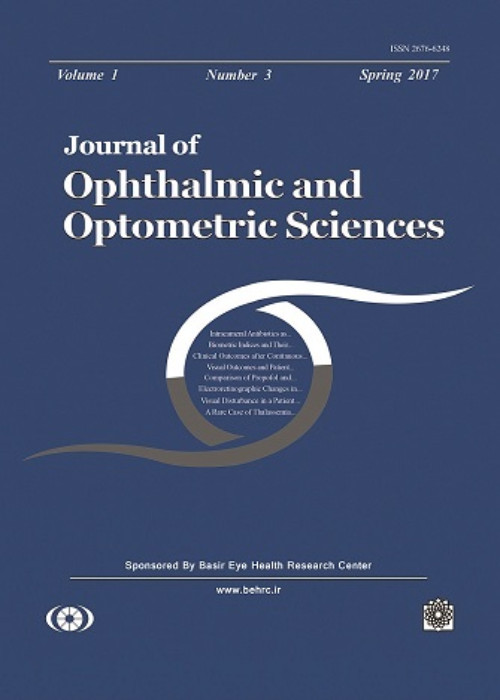فهرست مطالب

Journal of Ophthalmic and Optometric Sciences
Volume:6 Issue: 3, Summer 2022
- تاریخ انتشار: 1402/07/30
- تعداد عناوین: 6
-
-
Pages 1-6Purpose
This study aims to investigate the visual acuity and prognosis after photorefractive keratectomy among hyperopic patients with and without astigmatism.
Patients and MethodsIn this interventional case series study, 74 eyes from 42 hyperopia patients with and without astigmatism who underwent photorefractive keratectomy using Allegretto EX500 excimer laser at Torfeh and Negah Eye Hospitals from 2014 to 2018 were enrolled. Pre-and postsurgical visual examination findings, including uncorrected distance visual acuity, corrected distance visual acuity, manifest refraction, cyclorefraction, and slit lamp examinations to measure ocular pressure and the presence or absence of haze, were recorded.
ResultsThe mean age of participants was 34 ± 9 years, and 54.8 % were female. The preoperative mean uncorrected distance visual acuity was 0.55 ± 0.25 LogMAR, which significantly improved to 0.11 ± 0.14 at 6 months postoperatively (P < 0.0001). The predictive value for surgical outcomes at six months post-operation was 71.6 % within ± 0.5 diopter, 89.2 % within ± 1 diopter, and 97.3 % within ± 2 diopters. No eye lost corrected distance visual acuity of two lines or more, and only 16.6 % (12 eyes) experienced a one-line reduction in corrected distance visual acuity. No other notable complications occurred.
ConclusionPhotorefractive keratectomy using Allegretto EX500 excimer laser is an effective and safe method for correcting mild to moderate hyperopia with or without astigmatism.
Keywords: Photorefractive Keratectomy, Hyperopia, Astigmatism, Outcome -
Pages 15-19Purpose
The present study aimed to assess the effect of refractive error (RE) correction on stereopsis.
Patients and MethodsA total of 62 participants underwent comprehensive ophthalmic examinations, which included measurements of visual acuity, RE, stereopsis, ocular alignment, as well as examinations of the anterior and posterior ocular segments. Stereopsis was evaluated using the TNO random dot stereogram booklet at a distance of 33 cm, both with and without RE correction. The results were then compared to evaluate the impact of RE correction on stereopsis.
ResultsOur findings revealed that correcting one diopter of the spherical and spherical equivalent components of RE led to a significant improvement in stereopsis, with improvements of 30.884 and 30.373 seconds of arc, respectively (P = 0.001). However, the correction of other components of RE did not demonstrate a statistically significant effect on improving stereopsis. Additionally, we found no significant correlation between different types and severities of refractive errors and stereopsis.
ConclusionCorrecting the spherical and spherical equivalent components of refractive error may enhance stereopsis across various types of refractive errors.
Keywords: Refractive Errors, Myopia, Stereopsis -
Pages 20-27Purpose
To investigate the effect of cataract surgery on dry eye.
Patients and MethodsIn this prospective observational study, patients who were candidates for cataract surgery were enrolled, and three methods for evaluating dry eye, such as the ocular surface disease index (OSDI) questionnaire, Schirmer 1 test, and non-invasive tear film break-up time (NIBUT) measured using the Sirius device, were utilized before surgery and one month after surgery, and the results were compared.
ResultsEighty eyes of 80 patients, including 34 males and 46 females, were included in the study. The mean age of the patients was 65.2 ± 7.3 years. In the conducted evaluations, the numerical results of the OSDI questionnaire increased from 27.52 ± 12.26 before the surgery to 32.42 ± 13.91 one month after surgery (P < 0.01). The tear film break-up time using the Sirius device before surgery was 8.52 ± 5.09 seconds, which decreased to 5.37 ± 3.73 seconds after surgery (P < 0.001). In the Schirmer 1 test, the results changed from 7.89 ± 2.25 millimeters before surgery to 7.42 ± 2.38 millimeters after surgery (P < 0.01).
ConclusionThis study’s results suggest that cataract surgery is a predisposing factor for increased dry eye symptoms and can exacerbate the severity of the disease in patients with a history of dry eye.
Keywords: Dry Eye, Cataract, Schirmer Test, Ocular Surface Disease Index -
Pages 28-32
Morning glory syndrome is a rare congenital excavated optic disc anomaly that can impair vision and may be associated with ocular and non-ocular abnormalities. It is characterized by a large excavated disc with radial vessels and a central turf of glial tissue within a funnel-shaped excavation of the posterior fundus. This syndrome is more common in Caucasians than in individuals of African descent. In this case report, we describe a unique case of morning glory syndrome with a fullthickness macular hole.
Keywords: Morning Glory Syndrome, Macular, Hole, Optical Disk -
Pages 33-36
Psychogenic vomiting is a condition characterized by recurrent vomiting without any known organic cause resulting from psychological stress. This report presents the case of an eleven-year-old male child with severe unexplained visual loss who was referred for visual evoked potential (VEP) recording. However, during the procedure, the child experienced a sudden episode of psychogenic vomiting after the electrodes were fixed and before the experiment began. This report aims to explore the possible reasons behind this episode and propose potential solutions to prevent similar conditions from occurring.
Keywords: Psychogenic Vomiting, Visual Evoked Potential, Reduced Visual Acuity -
Pages 37-51
Descemet’s Membrane Endothelial Keratoplasty (DMEK) is a type of lamellar (partial thickness) corneal transplantation in which the endothelium, along with Descemet’s membrane, is transferred. This technique has gained increased popularity in recent years and is expected to become more prominent and widely used among the various types of corneal transplantation. This review article provides a step-by-step guide for corneal surgeons on conducting DMEK. Like any other surgical procedure, gaining experience and completing consecutive surgeries can improve the delicate and precise execution of this procedure. Watching videos, observing live surgeries performed by experienced surgeons who have sufficient expertise in this procedure, and ultimately performing the surgery under the guidance of experienced individuals are factors that contribute to better surgical outcomes. This text serves solely as a guide for performing the continuous stages of DMEK.
Keywords: Descemet’s Membrane, Endothelial, Keratoplasty, Guide

